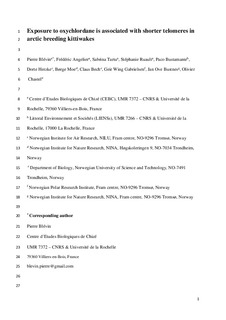| dc.contributor.author | Blévin, Pierre | |
| dc.contributor.author | Angelier, Frédéric | |
| dc.contributor.author | Tartu, Sabrina | |
| dc.contributor.author | Ruault, Stéphanie | |
| dc.contributor.author | Bustamante, Paco | |
| dc.contributor.author | Herzke, Dorte | |
| dc.contributor.author | Moe, Børge | |
| dc.contributor.author | Bech, Claus | |
| dc.contributor.author | Gabrielsen, Geir W. | |
| dc.contributor.author | Bustnes, Jan Ove | |
| dc.contributor.author | Chastel, Olivier | |
| dc.date.accessioned | 2018-01-23T09:39:35Z | |
| dc.date.available | 2018-01-23T09:39:35Z | |
| dc.date.created | 2016-05-02T12:16:31Z | |
| dc.date.issued | 2016 | |
| dc.identifier.citation | Science of the Total Environment. 2016, 563-564 125-130. | nb_NO |
| dc.identifier.issn | 0048-9697 | |
| dc.identifier.uri | http://hdl.handle.net/11250/2478959 | |
| dc.description.abstract | Telomeres are DNA-protein complexes located at the end of chromosomes, which play an important role in maintaining the genomic integrity. Telomeres shorten at each cell division and previous studies have shown that telomere length is related to health and lifespan and can be affected by a wide range of environmental factors. Among them, some persistent organic pollutants (POPs) have the potential to damage DNA. However, the effect of POPs on telomeres is poorly known for wildlife. Here, we investigated the relationships between some legacy POPs (organochlorine pesticides and polychlorobiphenyls) and telomere length in breeding adult black-legged kittiwakes (Rissa tridactyla), an arctic seabird species. Our results show that among legacy POPs, only blood concentration of oxychlordane, the major metabolite of chlordane mixture, is associated with shorter telomere length in females but not in males. This suggests that female kittiwakes could be more sensitive to oxychlordane, potentially explaining the previously reported lower survival rate in most oxychlordane-contaminated kittiwakes from the same population. This study is the first to report a significant and negative relationship between POPs and telomere length in a free-living bird and highlights sex-related susceptibility to banned pesticides. | nb_NO |
| dc.language.iso | eng | nb_NO |
| dc.publisher | Elsevier | nb_NO |
| dc.rights | Attribution-NonCommercial-NoDerivatives 4.0 Internasjonal | * |
| dc.rights | Attribution-NonCommercial-NoDerivatives 4.0 Internasjonal | * |
| dc.rights.uri | http://creativecommons.org/licenses/by-nc-nd/4.0/deed.no | * |
| dc.rights.uri | http://creativecommons.org/licenses/by-nc-nd/4.0/deed.no | * |
| dc.title | Exposure to oxychlordane is associated with shorter telomeres in arctic breeding kittiwakes | nb_NO |
| dc.type | Journal article | nb_NO |
| dc.type | Peer reviewed | nb_NO |
| dc.description.version | acceptedVersion | nb_NO |
| dc.source.pagenumber | 125-130 | nb_NO |
| dc.source.volume | 563-564 | nb_NO |
| dc.source.journal | Science of the Total Environment | nb_NO |
| dc.identifier.doi | 10.1016/j.scitotenv.2016.04.096 | |
| dc.identifier.cristin | 1353560 | |
| dc.relation.project | Norges forskningsråd: 234423 | nb_NO |
| dc.description.localcode | © 2016 Elsevier B.V. All rights reserved. This is the authors' accepted and refereed manuscript to the article. Locked until 29 April 2018 due to copyright restrictions. | nb_NO |
| cristin.unitcode | 194,66,10,0 | |
| cristin.unitname | Institutt for biologi | |
| cristin.ispublished | true | |
| cristin.fulltext | postprint | |
| cristin.qualitycode | 2 | |

